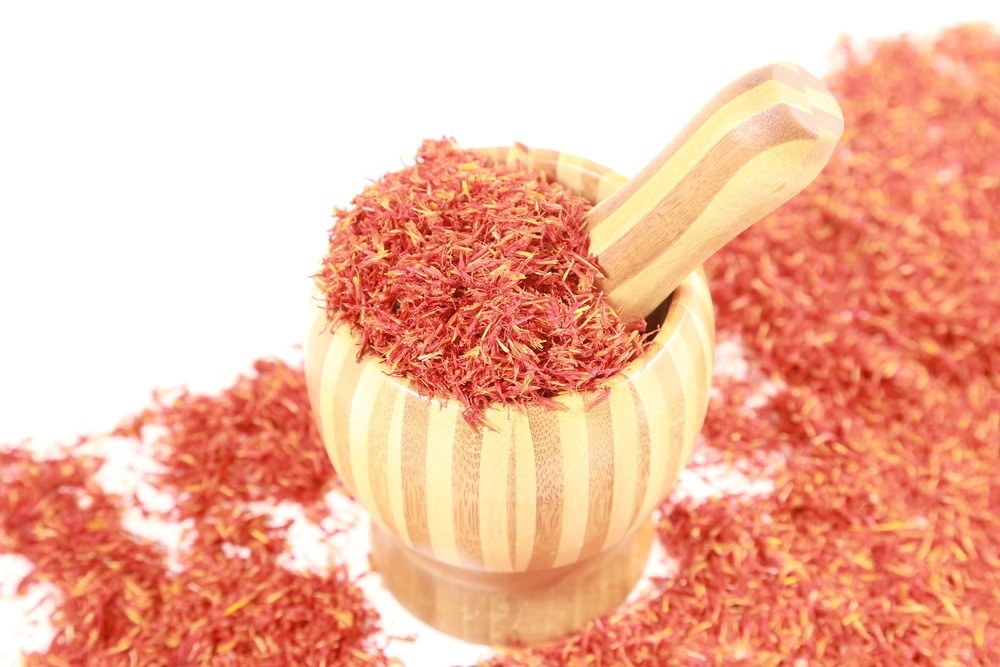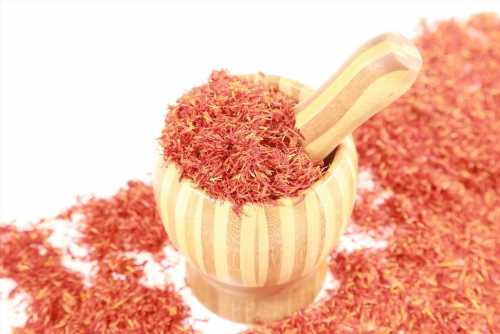In a recent study published in Scientific Reports, researchers investigated the potential anti-coronavirus disease 2019 (COVID-19) activity of traditional Chinese medicine (TCM).

Background
Honghua herb, Carthami flos, has been used for treating several diseases such as coronary heart disease, angina pectoris, and hypertension, among others. Likewise, Xihonghua herb or saffron, Croci stigma, has been used to treat fever, bronchitis, asthma, atherosclerosis, anxiety, and depression.
One study showed that crocetin, found in Xihonghua, had a high binding affinity for the spike protein and protease of severe acute respiratory syndrome coronavirus 2 (SARS-CoV-2), making it a promising candidate for treating COVID-19. Kinase elevation is characteristic of host cell response during SARS-CoV-2 infection. Thus, kinases could be potential targets for developing anti-COVID-19 therapeutics.
About the study
In the present study, researchers evaluated the potential of Honghua and Xihonghua herbs in COVID-19 treatment. The dried Honghua and Xihonghua stigmas were commercially obtained from local pharmacies. Decoctions were prepared by boiling them at 100 °C, followed by filtration using a 200 nm filter. Phosphatase activity was measured using nitro-blue tetrazolium (NBT)/5-Bromo, 4-chloro, 3’-indolyl phosphate (BCIP).
The active components of Honghua and Xihonghua were identified from the TCM systems pharmacology and analysis platform (TCMSP) database. Honghua and Xihonghua were used as input terms to retrieve compounds with an oral bioavailability (OB) of 30% or higher and drug-likeliness (DL) of 0.18 or higher.
COVID-19-associated genes were identified using GeneCards with the following inputs ‘COVID-19’, ‘kinase,’ or ‘alkaline phosphatase (ALP).’ Metascape and Venny 2.1 tools generated intersections of Honghua/Xihonghua with COVID-19-associated genes. Intersection targets were analyzed using Search Tool for the Retrieval of Interacting Genes/Proteins (STRING), and the protein-protein interaction (PPI) network was constructed using Cytoscape.
Further, three-dimensional structures of Honghua/Xihonghua components and corresponding receptors were obtained from PubChem and Protein Data Bank (PDB), respectively. Receptor proteins were dehydrated, and molecular docking was performed.
Findings
The Honghua and Xihonghua herbs comprised 21 and five components, respectively, which met the required OB and DL characteristics. Four additional compounds – safranal, crocin I and II, and picrocrocin, from Xihonghua, were selected from the literature.
Functional enrichment performed using the database for annotation, visualization, and integrated discovery (DAVID) revealed 75 biological processes that (the components of) Honghua could be involved. Inflammatory response, platelet activation, and proteolysis, among others, were the most enriched processes.
Similarly, Xihonghua components were involved in processes such as proteolysis, protein phosphorylation, platelet activation, positive regulation of cell proliferation, and response to hypoxia and drugs. Additionally, 20 enriched molecular functions of Honghua were identified, which included mitogen-activated protein kinase (MAPK) activity, scaffold protein binding, and virus receptor activity. Likewise, Xihonghua was enriched in 12 functions, including ATP binding, endopeptidase activity, fibronectin binding, etc.
The nanozyme activity of the two herbal extracts was tested. Honghua extracts exhibited phosphatase activity comparable to that of the ALP enzyme. The authors found that pH affected the nanozyme activity of the herbs. The highest activity of both herbal extracts was observed at pH 13; Honghua was poorly active at a broader pH range, while Xihonghua was barely active at a pH other than 13.
The potential of herbal extracts for kinase activity was assessed in a pathway analysis. First, the intersection of all herbal components was applied without OB, DL selection, and kinase-related genes. Most pathways were common to the two herbs. In contrast, tuberculosis and proteoglycans in cancer pathways were unique to Honghua, and the tumor necrosis factor (TNF) signaling pathway and influenza were unique to Xihonghua.
When analyzed using COVID-19/kinase intersection genes, PI3K-AKT signaling and FOXO signaling were unique to Honghua and Xihonghua, respectively. Molecular docking of herbal components with human angiotensin-converting enzyme 2 (hACE2) revealed hydrogen bonds and hydrophobic interactions between herbal components (crocin, picrocrocin, and safranal) and hACE2.
Conclusions
In conclusion, the authors proposed that components and nanozyme activity of the Honghua and Xihonghua herbs could inhibit SARS-CoV-2 signaling via kinase and other pathways. Honghua and Xihonghua compounds exhibited phosphatase nanozyme activity, and crocin had the most-potent ACE2 binding. Moreover, researchers added that Honghua and Xihonghua should be explored further for their anti-COVID-19 activities and to develop SARS-CoV-2 entry inhibitors.
- Madikyzy, M. et al. (2022) "Honghua extract mediated potent inhibition of COVID-19 host cell pathways", Scientific Reports, 12(1). doi: 10.1038/s41598-022-15338-9. https://www.nature.com/articles/s41598-022-15338-9
Posted in: Medical Science News | Medical Research News | Disease/Infection News
Tags: ACE2, Angina, Angina Pectoris, Angiotensin, Angiotensin-Converting Enzyme 2, Anxiety, Asthma, Atherosclerosis, binding affinity, Bronchitis, Cancer, Cell, Cell Proliferation, Coronary Heart Disease, Coronavirus, Coronavirus Disease COVID-19, covid-19, Depression, Drugs, Enzyme, Fever, Genes, Heart, Heart Disease, Hypoxia, Influenza, Kinase, Medicine, Necrosis, pH, Pharmacology, Phosphatase, Phosphorylation, Platelet, Proliferation, Protein, Receptor, Respiratory, Saffron, SARS, SARS-CoV-2, Severe Acute Respiratory, Severe Acute Respiratory Syndrome, Signaling Pathway, Spike Protein, Syndrome, Therapeutics, Tuberculosis, Tumor, Tumor Necrosis Factor, Virus

Written by
Tarun Sai Lomte
Tarun is a writer based in Hyderabad, India. He has a Master’s degree in Biotechnology from the University of Hyderabad and is enthusiastic about scientific research. He enjoys reading research papers and literature reviews and is passionate about writing.
Source: Read Full Article
